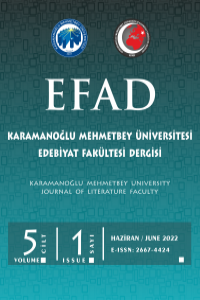Borges’in “Döngüsel Yıkıntılar” Adlı Öyküsünün İmgelem Kuramı Açısından İncelenmesi
Jorge Luis Borges, Döngüsel Yıkıntılar, Sonsuz Döngüsellik, İmgelem Kuramı, Gilbert Durand.
An Analysis of Borges’s “The Circular Ruins” in Terms of Imagination Theory
Jorge Luis Borges, The Circular Ruins, Infinite Regression, Theory of Imagination, Gilbert Durand.,
___
- Borges, J. L. (2017). Ficciones, Hayaller ve Hikâyeler. (T. Uyar, Çev.) İstanbul: İletişim Yayınları, (1944).
- Borges, J. L. (1984). Obras Completas. Cilt (I). Buenos Aires: Emecé Editores.
- Cano López, A. J. (2011). La teoría de las pasiones de Hume. Daimon: Revista Internacional de Filosofía, 52, 101-115.
- Chevalier, C. & Gheerbrant, A. (1986). Diccionario de los símbolos. Barcelona, Editorial Herder.
- Cirlot, J. E. (2018). Diccionario de símbolos. Madrid: Ediciones Siruela.
- Durand, G. (1981). Las estructuras antropológicas de lo imaginario: Introducción a la arquetipología. Madrid: Taurus Ediciones
- Durand, G. (2017). Sembolik İmgelem. (A. Meral, Çev.) İstanbul: İnsan Yayınları, (1964)
- Durand, G. (2000). Lo Imaginario. Barcelona: Ediciones del Bronce.
- Fordham, F. (1997). Jung Psikolojisi. (A. Yalçıner, Çev.) İstanbul: Say Yayınları, (1953)
- Geçtan, E. (1998). Psikanaliz ve Sonrası. İstanbul: Remzi Kitabevi.
- İlgürel, M. (2013). Jorge Luis Borges'in Öykülerinde Zaman ve Uzam. Yayımlanmamış Doktora Tezi. İstanbul, Türkiye: İstanbul Üniversitesi Sosyal Bilimler Enstitüsü.
- İlgürel, M. (2016). Julio Cortázar'ın Öykülerinin Sembolik İmgelemi. İstanbul: Yeni İnsan Yayınevi.
- İlgürel, M. (2019). Análisis arquetípico de “Ese puerto existe” de Blanca Varela. A.A. Donizeti da Cruz, M. F. Gonçalves Lima, M. İlgürel (Haz.), Redes do Imaginário: Literatura, Memória e Resistência İçinde (ss. 15-40), Cascavel, UNIOESTE.
- Jung, C. G. (2014). The Collected Works of C.G. Jung: Complete Digital Edition. Princeton: Princeton University Press.
- Minkowski, E. (1927). L'autisme et les attitudes schizophréniques. Paris: Journal Psych.
- Samuels, A., Shorter, B., & Plaut, F. (2003). A Critical Dictionary of Jungian Analysis. New York: Brunner-Routledge.
- Yayın Aralığı: Yılda 2 Sayı
- Başlangıç: 2018
- Yayıncı: Karamanoğlu Mehmetbey Üniversitesi
İbrahim BOZKURT, İbrahim Halil AYTAR
Konstantin Nikolayeviç Leontyev, (2022) Bizansçılık ve Slavlık
Jale PARLA, (2021) Don Kişot’tan Bugüne Roman
Yaşlı Bakım Hizmetlerinde Duygusal Emeğin Kaynağı ve Oluşumuna İlişkin Fenomenolojik Bir Araştırma
Borges’in “Döngüsel Yıkıntılar” Adlı Öyküsünün İmgelem Kuramı Açısından İncelenmesi
İçel’de Unutulmuş Bir Osmanlı Kalesi: İkisırma/İkisırama
Herakles-Deianeira-Nessos Bir Yunan Mitolojisi ve Görsel Yorumu
Kırgızistan’da Yoksulluk ve Yoksulluk Çalışmaları
Sosyolojik Eleştiri Kuramına Örnek Bir İnceleme: Değirmen Öykü Kitabı
